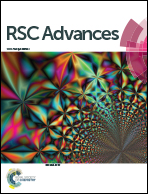Ionic liquid polymer functionalized carbon nanotubes-coated polyaniline for the solid-phase microextraction of benzene derivatives†
Abstract
Multiwalled carbon nanotubes (MWCNTs) were non-covalently functionalized with poly(imidazolium ionic liquids) (PILs), and the resulting PIL/MWCNTs composite suspension was coated on electrodeposited polyaniline (PANI) film to fabricate a novel solid-phase microextraction coating (PANI-PIL/MWCNTs). The coating showed porous structure and had large specific surface area (231 m2 g−1, determined by the Brunauer–Emmett–Teller N2 adsorption method). Its adsorption properties were explored by preconcentrating benzene derivatives from water samples prior to gas chromatography-flame ionization detection. The results showed that the PANI-PIL/MWCNTs composite had high enrichment capacity for the analytes and high stability for repeatable use, due to the synergistic effect of PANI and PIL/MWCNTs. Hence, a detection method was developed for them, and good linearity (correlation coefficients higher than 0.9953), low limits of detection (17.7–32.6 ng L−1) and high precision (relative standard deviations less than 6.5% (n = 5)) were achieved. The method was applied to the determination of the benzene derivatives in real samples with recoveries of 84.0–106.9%.


 Please wait while we load your content...
Please wait while we load your content...